There comes a point in every succulent addict's journey where they begin looking into purchasing grow lamps to help their indoor collection thrive.
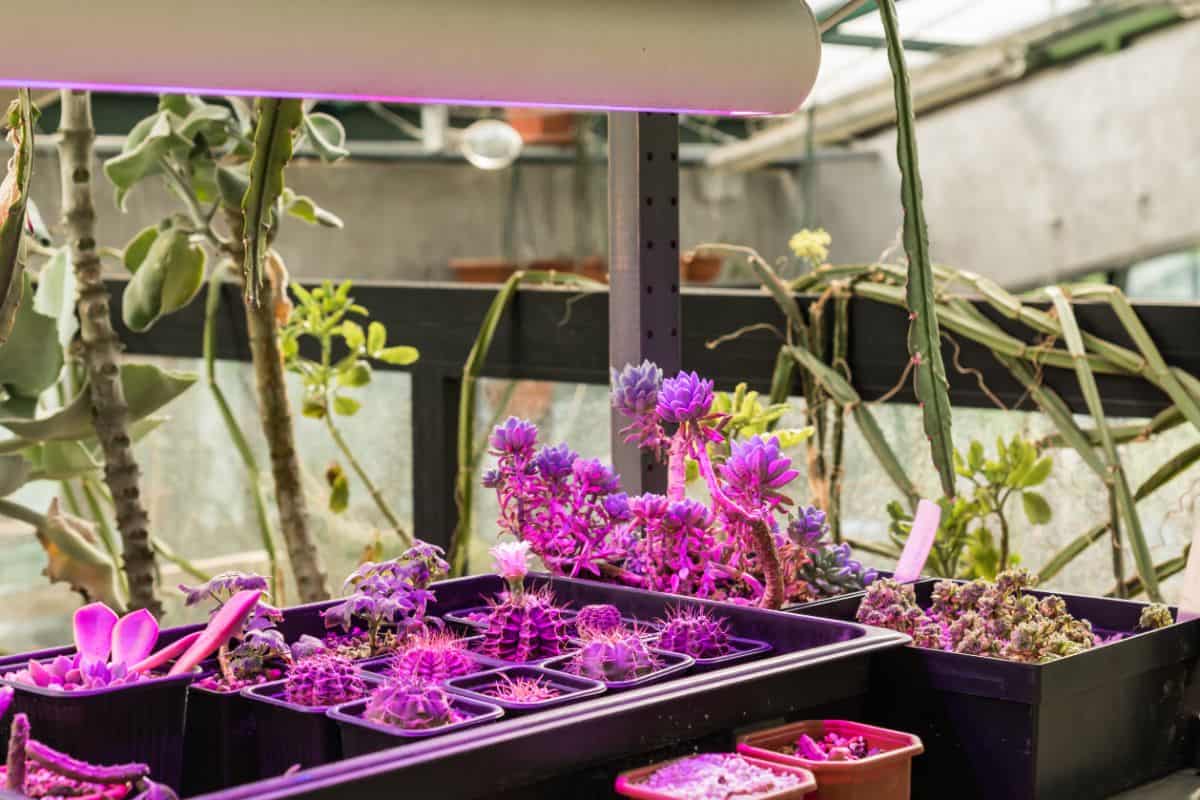
There are a lot of reasons you might want a grow light (also referred to as a grow lamp). Perhaps none of your windows can provide enough light to your windowsill plants. Perhaps, like me, you've just run out of space on every window sill.
Or, maybe you're trying to overwinter your succulents indoors without them suffering etiolation.
Grow lights are gonna change the way we play this succulent game. They are an easily implemented solution that increases your plant capacity. Your obsession will be enabled to a greater extent than ever before.
Jump to:
What are Grow Lights?
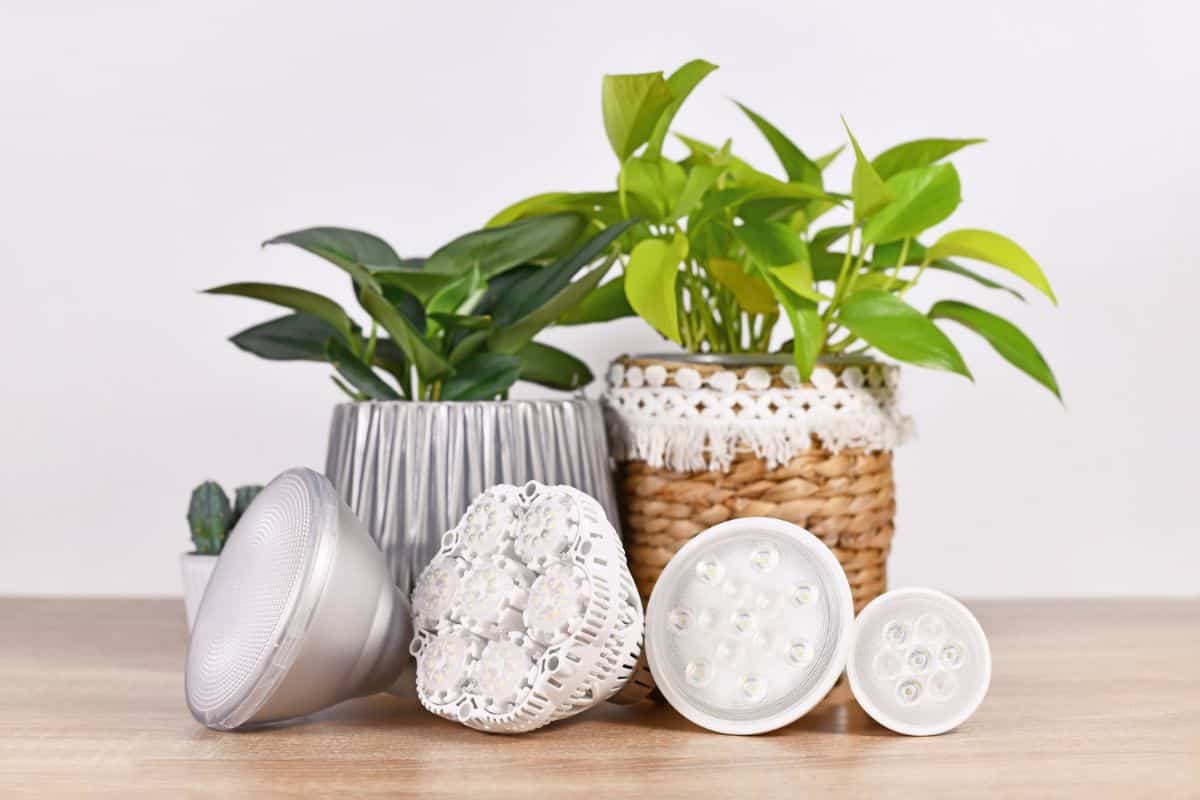
"Grow light" isn't a technical term, nor is it a unique piece of technology. Any light can be a "grow light" since plants really aren't that picky about where the light comes from.
What sets grow lights apart from regular lights is the spectrum of light they emit when powered. Your typical lamp uses “soft” and/or “warm” light. The “temperature” of light is measured in Kelvin (K) rather than Fahrenheit, which is why you’ll see lights labeled as 2700K. Warm lights tend to be yellowish and fairly weak as far as lumens (light power) are concerned.
Grow lights are often (but not always) “full spectrum” lights. That means they contain the full visible spectrum of light, from red to violet, plus a little extra on both sides – a touch of ultraviolet light can be beneficial. These lights are often described as “white/blue” or “cool” or “daylight” and usually measure around 3500K to 6500K on the Kelvin scale.
So, no, they don’t function any differently than other lights. The spectrum a lightbulb produces is determined by the components with which they are manufactured. Full spectrum bulbs will come in a variety of wattages, voltages, sizes, and base types.
Why Use a Grow Light?
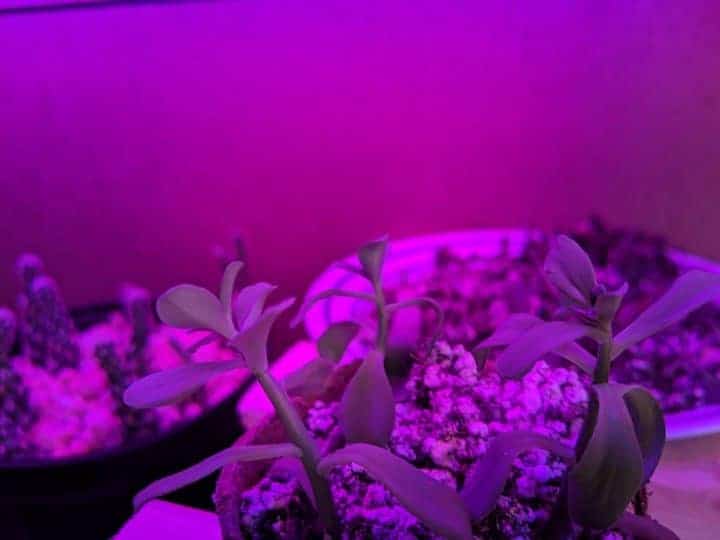
Grow lights are pretty nifty for hobby gardeners and commercial growers alike. Here are some common uses for grow lights:
- Growing plants entirely indoors
- Starting seeds or propagations
- Extending the growing season of some herbs and veggies
- Supplement insufficient natural light
That last one is pretty important to us succulent-growers. Have you had ever problems with succulents turning out just plain green instead of all those vibrant colors Pinterest promised? Or you order plants that look really pretty and then slowly fade to dull green over a few weeks?
Yup, that's because they haven't gotten enough light (or not enough strong light). You can kind of break downlight needs into 3 levels.
- Level 1 - The bare minimum amount of light a plant needs to survive. It's quite low, actually, in the case of most succulents. Internal rooms of a house would often be at this level. Plants getting this much light will etiolate if left in these conditions for any significant length of time.
- Level 2 - This is the minimum amount of light a plant needs to avoid etiolation (stretching). There's a pretty big gap between level 1 and level 2. It's totally possible to have a plant under a grow light and it still becomes etiolated (if the light is too far away or not strong enough).
- Level 3 - The amount of light necessary for a succulent's "true colors" to appear (also called "sun-stress" or "sunblush"). The gap between level 2 and 3 isn't that wide, actually. Once you've successfully avoided etiolation, it usually just requires a little more light.
That's hardly a scientific explanation, but it helps to know what you're up against.nowing the specific light requirements of each plant species in your collection will help you to determine how much light you actually need to provide. Remember, when it comes to growing succulents and cacti, knowledge is power! Although every plant is different, the answer to most of the aesthetic issues of succulents is just more light.
Grow lights are especially useful for windowsill succulents. South-facing windows have the best light (if you're in the northern hemisphere). I've found that those are the only succulents in my house that develop their sunblush naturally. Succulents in any other window tend to stay green unless they also get a little love from a grow light.
This is especially pertinent during winter when both daylight hours are shorter AND light intensity is lower. Your succulents are at increased risk of not only becoming a boring green but also becoming etiolated... for which there is no cure.
Except for beheading. Seriously.
Types of Grow Lights
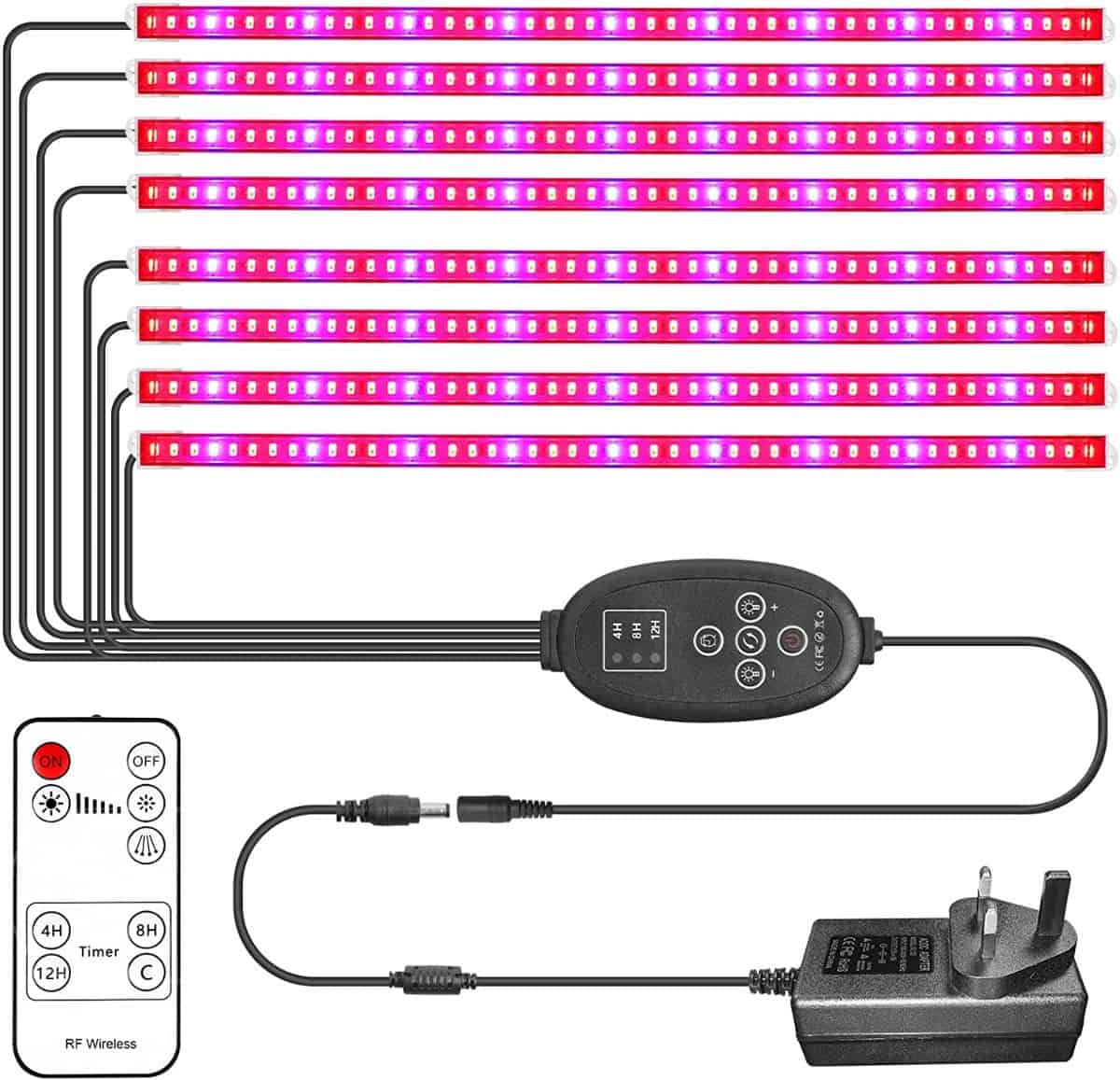
There are a couple main types of grow lamps. We will ignore the incandescent ones for a few reasons: they're energy inefficient, the produce too much heat, and they don't hit the proper light spectrum. Let's talk about fluorescent and LED grow lamps.
Fluorescent Grow Lamps
Tube Lights
Tube lights come in several flavors, but there's a clear winner you should pretty much always choose.
You've seen the T5, T8, and T12 stuff, right?
Well, the 'T' just means tube, while the number denotes the diameter in eighths of an inch.
Therefore, a T5 is a tube light with a diameter of ⅝ inches. Tube lights can come in any length, but 1, 2, 4, and 8 foot are most common.
Also, tube lights will often come in a large fixture with multiple tubes.
These are meant for scaled-up growing operations and are accordingly more expensive.
As it turns out, you should really only ever buy T5 lights. Both of the other kinds are older technology that is significantly less efficient.
No products found.
T5s last longer, use less energy, and produce more light.
I use a couple of single tube lights to supplement my windowsill set up. This is the one I've been using, and I'm pretty pleased with it.
CFL Lights
If you don't have space or don't like the aesthetic of a long, tubular light, grow lights also come in the CFL variety.
That acronym means "Compact Fluorescent Light".
These are just like regular light bulbs and can fit in any regular socket.They’re also available in a variety of different wattages, temperatures (in Kelvin), and base types. They usually have a lifespan of around 6,000 to 15,000 hours, so you won’t need to plan on replacing them frequently.
If you have one or two plants on a desk in your office or at home, these are an ideal fix.
Just switch out that old bulb on your desk lamp with one of these bad boys and get growin'!
Note that there also exists High Output and Very High Output (HO and VHO, respectively) fluorescent bulbs.
They are exactly what you think - they put out more energy and light!
If you choose one of these types, make sure you hang them further away from your plants, as they put out more heat! Just because you’re growing your succulents under artificial light, doesn’t mean you don’t have to worry about burning them!
LED Grow Lamps
LED stands for "Light Emitting Diode". It presents a unique opportunity for growers - it allows you to give your plants specific wavelengths of light!
Why is that useful? Well, it just so happens that most plants really only care about two kinds of light. Red light and blue light.
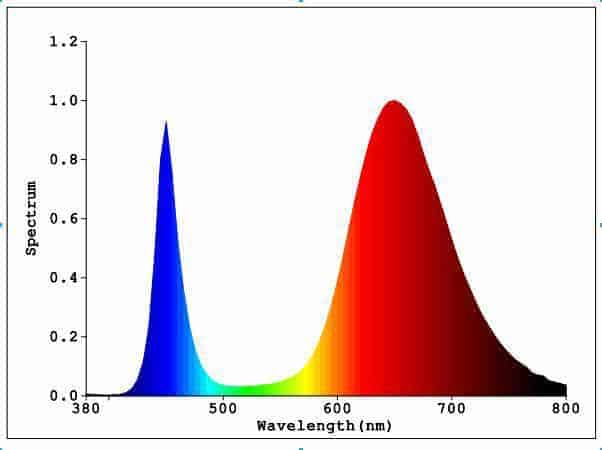
This is a generic graph of the light spectrum utilized by the majority of plants.
Notice that plants primarily use light of a wavelength that appears red or blue.
There is a conspicuous lack of green light being used. That's because chlorophyll (the thing that makes energy from light) is green.
It reflects green light, rather than absorbing it. That's also why most plants are green-colored!
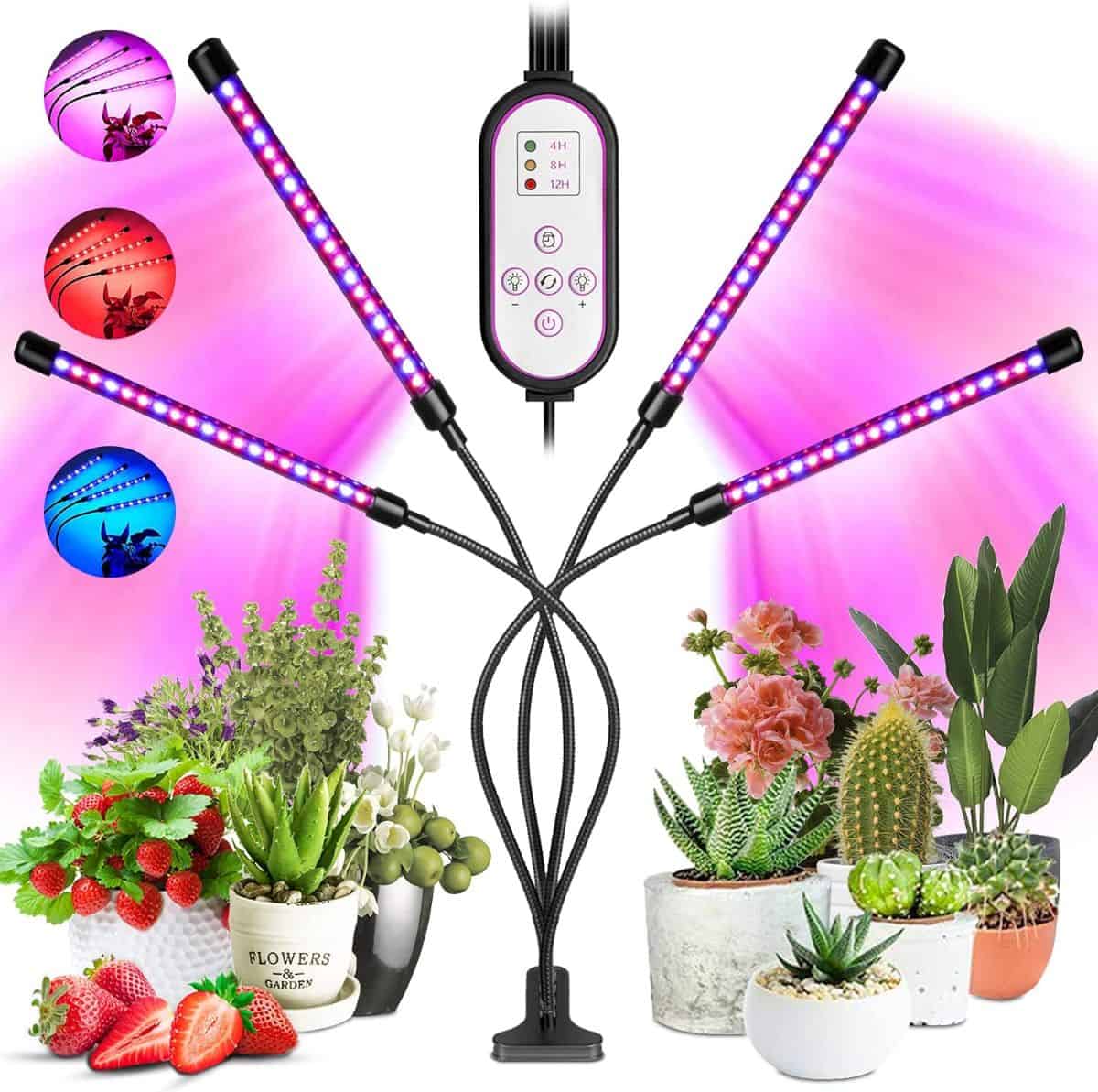
Back to LEDs.
Why give plants all this extra light they're not even going to use?
Each diode in an LED only emits a very narrow range of wavelengths, effectively just one color of light.
In doing this, they save even more energy and produce less heat than fluorescent bulbs!
That doesn't mean they are necessarily better though.
Giving a plant only specific wavelengths of light can trigger it to behave differently.
Some plants, for example, are encouraged to flower when exposed to specific ratios of red to blue light.
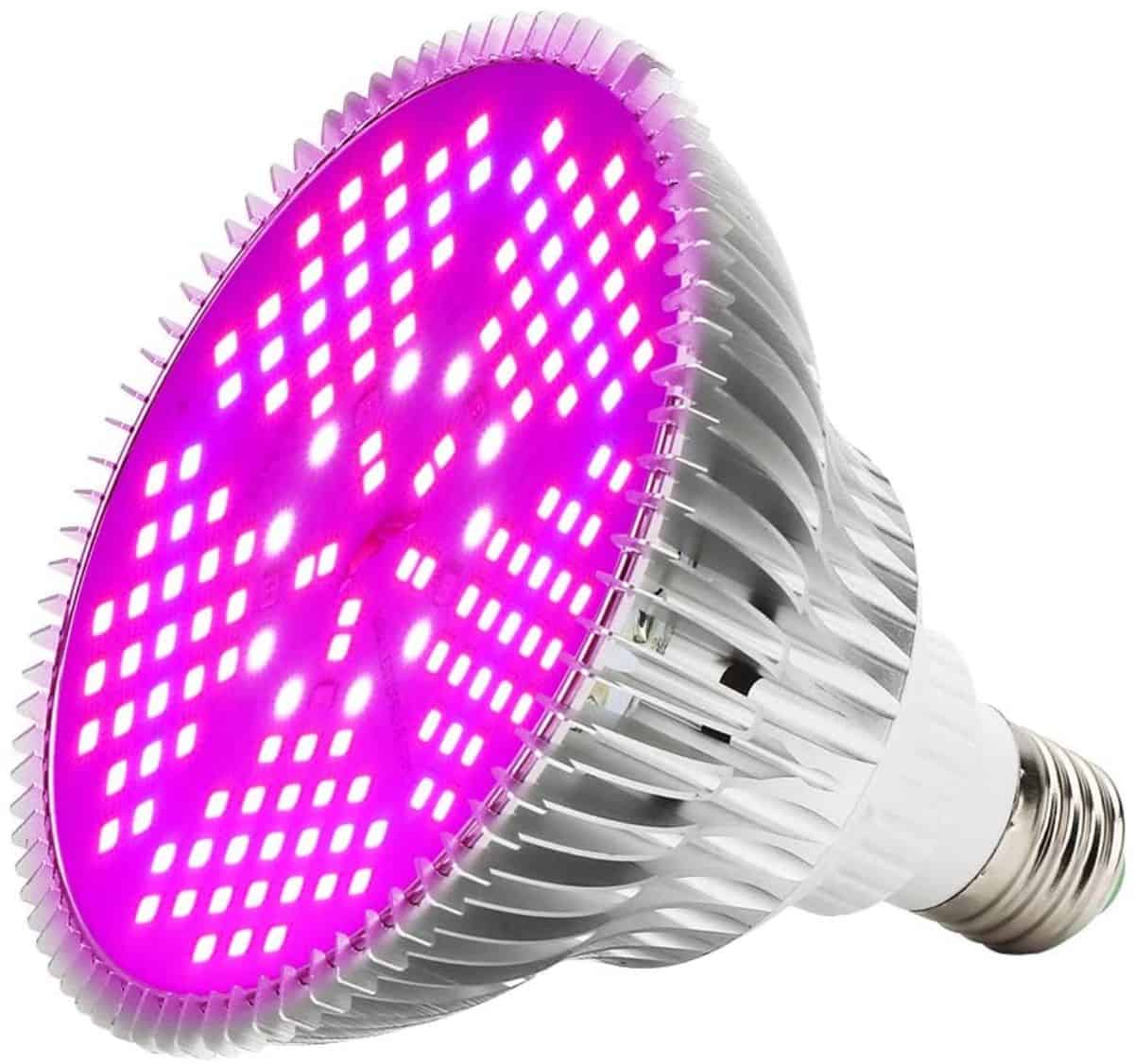
Mostly though, LEDs are a cost-effective way of ensuring constant vegetative growth (new leaves and the like). It's also used to germinate seedlings since it produces very little heat.
The biggest downside to LEDs is that they are often lacking in light power (lumens) and light intensity.
It's very difficult to get proper sun-stress colors using LED because they produce virtually no UV light (which is a part of light intensity).
At least you won’t be replacing them often, since most LED bulbs have a rated lifespan of up to 50,000 hours.
Like the fluorescent bulbs, LEDs come in many different shapes and sizes.
There are tubes, CFLs, fixtures, and even rolls of LED tape. You are sure to find one that fits your need if you look!
Positioning Grow Lights
There are a variety of factors that influence where you put your grow lights.
The goal is to balance light distribution with heat. Bulbs (moreso fluorescent ones) produce heat that will absolutely burn your plants if it's too close. Yet, you want them to be close in order to maximize the amount of light they receive. Also consider that you probably want a bulb to illuminate more than one plant at a time!
If you're using a simple LED or fluorescent bulb without any extra gimmicks, anywhere between 3 inches and 6 inches away from your plants will give you the best results. Of course, the exact distance depends on a plant's tolerances to light and heat.
Obvious plants that are used to extreme conditions, like cacti, will be able to handle more light and heat than more delicate species of succulents.
Does your grow lamp have a hood? Hoods reflect light down towards your plant (good), but they also reflect heat (bad). A hood can be useful in making sure more than one plant is getting enough light but be sure to, give your plants a few extra inches of space so that you don't scorch them.
Always monitor your succulents closely for a few days after changing lighting conditions to see how they react. It's possible to give them sunburns if the light is too intense or on for too long.
If you notice any brown spots or discoloration on your plants, you need to adjust the light as soon as possible. Discoloration is typically a sign of sunburn, which will permanently damage your plants if left unchecked.
You probably want to give them light for about 12-14 hours a day (I always use an outlet timer). If you’re unsure of how much light to give your plants, it’s best to err on the side of caution.
You can always increase the length of time they spend under the lights if they seem to be handling their current levels well. Succulents do need some darkness to maintain a healthy growing cycle, so plan on giving them a fairly big break from the lights each day. If you need to learn more about lighting succulents and cacti, check out this comprehensive guide.
Best Grow Lights for Succulents - Buying Guide
People often ask me to recommend a grow light for their situation. I encourage you to do your own research, but here are ones that I've used personally (or had recommended to me).
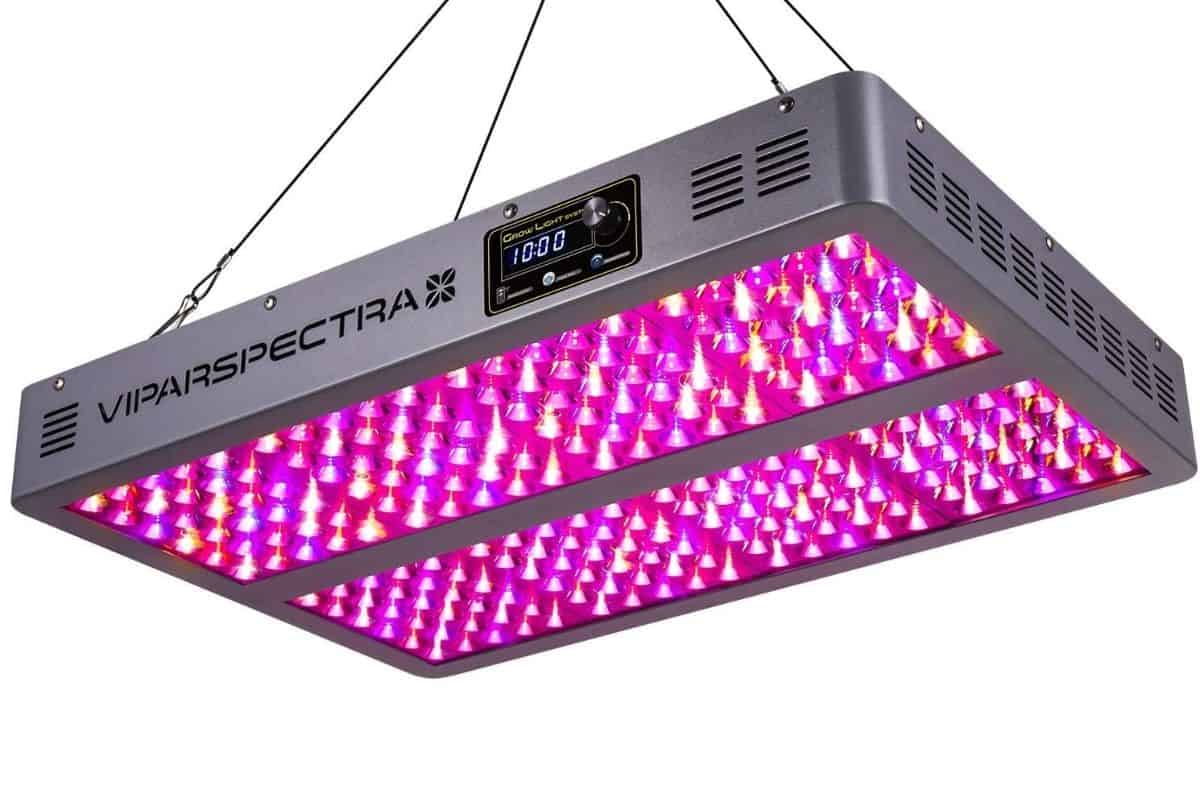
In general, I would opt for full spectrum grow lights whenever possible. The plants evolved with sunlight after all, so it makes sense to emulate it as best we can.
Best Supplementary Grow Lights
Like I mentioned earlier, I'm a big fan of tube lights. I have a couple of shelves around that have some tube lights hung over propagations and baby plants.
Tube lights are ideal for covering more than a few plants at a time and are probably the best option for gardeners with a large collection of succulents and cacti. However, if you’re short on space, these may not be your best option as the fixtures will take up more room. If you have the space to hang your lights above your plants, tube lighting will definitely be your best option.
If I ordered more, I would get ones that have a reflector this time around. I notice there's a lot of wasted light in my current set up.
If you have the budget, you may also be able to find air-cooled reflectors, which will help reduce the amount of heat that is reflected onto your plants. This will allow you to provide them with enough light but cut back on the risk of burning them. They can be expensive though, so you’ll need to do your research to decide if they’re right for you.
Best Desk or Table Grow Lights
My desk is the kitchen table so... I don't currently use one of these. However, I've given these away as gifts before to great appreciation.
I think that gooseneck clip-on lamps are best for use on desks. They can be out of the way and still adjusted to hit that little Echeveria that needs some love. These lights work well on windowsills too. If you're really feeling wild, they come in variations with 4 heads!
Clip-on lamps are also ideal for smaller collections or if you only have a few plants that you’re worried about. They’re also a little more portable than hanging light fixtures so you can move them around if necessary.
What Color of Light?
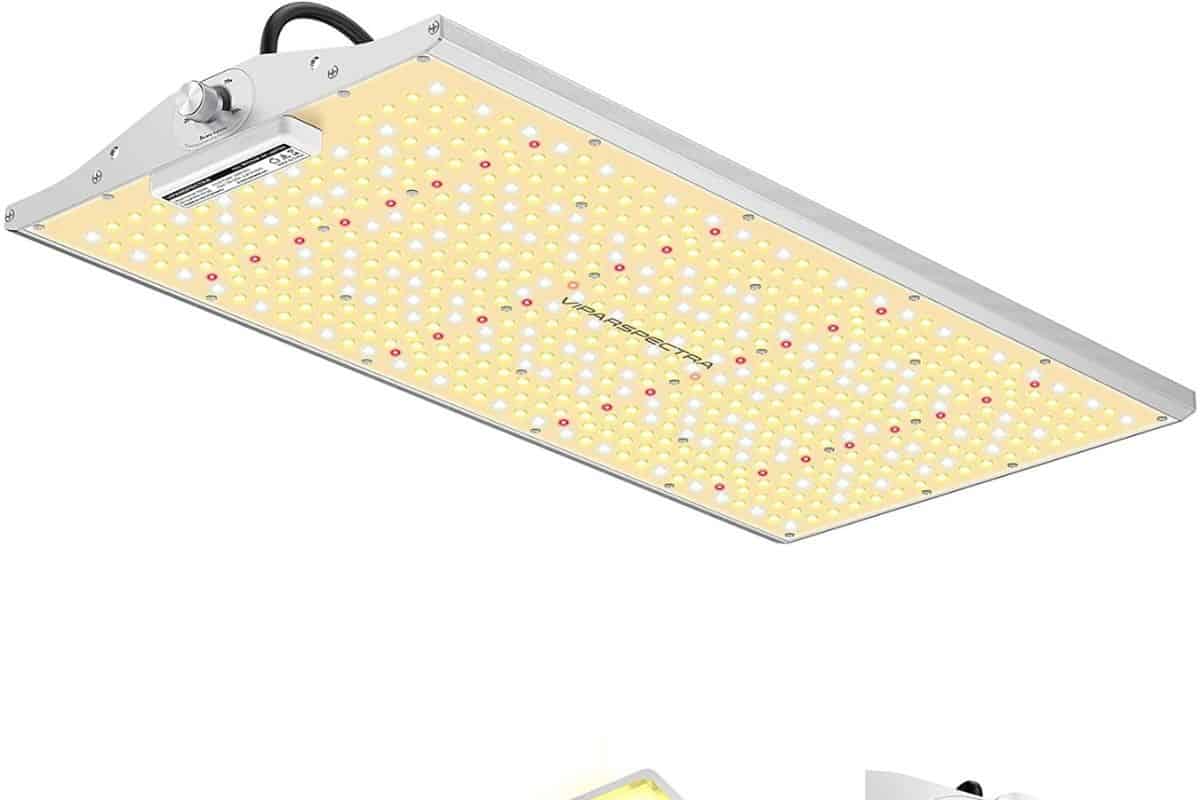
You may notice that many grow lights have both red and blue bulbs. During our previous discussion on LED lights, you learned that plants only really care about these two types of light. But what’s the difference?
The blue spectrum of your grow light to aid in photosynthesis, but don’t contribute as much to your plant’s growth as the red spectrum. Researchers at Michigan State University have discovered that blue light tends to suppress growth and plants grown solely in blue light tend to be shorter with thicker and darker colored leaves.
However, blue light is beneficial in regulating and encouraging flower growth in some species of plants, especially at higher intensities.
Red light is responsible for extension growth and those same researchers at MSU found that plants grown only under red light tend to be tall, thin, and elongated. The red light also had an effect on the flowering of the plants involved in the study.
Researchers concluded that the combination of red and blue lights was the most effective in terms of both growth and flowering. So that’s why most of the grow lights you see on the market today have both.
How Many Plants?
The number of plants you can keep under your grow lights will depend on the type of light you use and how many plants you own. Obviously, if you only have a few succulents and cacti, covering them all with a grow light will be relatively simple.
If you only have a few plants, you might want to consider clip-on or single bulb grow lights. This will allow your grow light to concentrate its efforts on a small space.
However, if you have a large collection of plants, or have particularly large succulents or cacti, you may need larger or multiple grow lights.
Hanging overhead lights are ideal for maximum coverage. As mentioned earlier, tube lights will cover the most plants.
If your succulent collection is spread throughout your home, rather than just in a single location, you may need to consider investing in multiple grow lights.
FAQs
Is a grow light good for succulents?
Yes! Grow lights are an excellent way to ensure that your precious plants are receiving enough light. By keeping our succulents indoors, we are able to grow succulents in what type of light is best for growing plants indoors?
Again, full-spectrum grows lights are recommended as they provide the range of wavelengths used by your succulents and cacti.
There is no single best type of light for growing indoor plants. The type of wide range of climates that they would be unlikely to survive in the wild.
Unfortunately, not all climates provide enough hours of sunlight in a day to keep succulents and cacti from etiolating. Grow lights are a great way to remedy this problem and provide your plants with plenty of sunlight no matter how dark your winter days get.
Grow lights are also a safe way to provide your plants with additional light without risking sunburn by exposing them to more sunlight.
How much grow light do succulents need?
The exact amount of light needed by your succulents will depend on their species and how much actual sunlight they receive on a daily basis. Generally, your plants will need at least six hours of light in order to thrive and prevent them from stretching out.
However, many gardeners recommend 12 to 14 hours of light per day for maximum effect. This can be achieved through a combination of natural sunlight and grow light. Your plants don’t really care what type of light they’re getting, just as long as they’re getting enough.
Depending on the amount of light your plants get during the day, you may just need to add a few hours with the grow light in the mornings or evenings. Unless your indoor space is normally a low light environment, you may also need to adjust your grow lights seasonally.
It’s important to remember that your plant’s light cycle is crucial in dormancy and blooming. Though most plants don’t really enter dormancy when kept indoors, it can be an essential part of getting your plants to bloom.
Holiday Cactus, for example, have specific needs when it comes to light and dormancy in order to bloom at the right time. If you’re trying to manipulate your plants into flowering, you may need to adjust the amount of light they get during certain seasons.
As always, be sure to research your plants to make sure you’re providing them with the right type of care and amount of light. It’s always helpful to group plants with similar needs together so you can be sure they’re growing in ideal conditions.
What kind of grow light is best for succulents?
As previously mentioned, full-spectrum lights are ideal for both succulents and cacti. Full-spectrum grows lights contain the entire spectrum of light. This will provide your succulents with the right spectrum of light to grow and bloom.
As far as the type of bulb or fixture goes, that will depend on your preferences and needs. Tube lights are beneficial in providing light to multiple plants while single bulb grow lights are ideal for concentrating the light on just a few plants.
Only you can decide what type of grow lamp is best for your succulent collection. Just be sure to consider how many outlets you have around your home, as this may affect how many grow lights you can keep in the areas where you’re growing succulents.
the light you use will depend on how you organize your plants in your space and what works best for you.
If you have space, tube lights are an excellent way of providing a lot of light to a lot of plants. If you’re looking for a more energy-efficient grow light, consider a light with LEDs.
If you need help choosing a grow light, check out our guide to the best grow lights for seedlings.
Did we miss anything? Do you have other questions? Ask below!
You Might Also Like:




Debbie
Great article! I’m going to purchase T-5 lights. Any suggestions as to reliable vendors? I am near
Lowe’s and Home Depot; will check them. Thx!
Patrick Grubbs
I haven't purchased tube lights from them before, but I have no doubt they carry them. I haven't had any trouble purchasing from sellers on Amazon that have at least 4 stars.
Kara
How can we determine how many hours of light succulents need from grow lights? Mine were stretching so I thought they needed more light but now I've been told they might be growing too much because they have so much light. They confuse me so!
Patrick Grubbs
An abundance of light might cause them to grow, but the certainly shouldn't be stretching if that's the case! Be sure that your light is close (within 1 foot if possible). 12-14 hours is ideal, unless you want them to go into winter dormancy - then try 8-10.
Janet
I have a very small office at work with LED ceiling lighting right above my desk, and no window. Will succulents survive? I can move them to a bright sunny location on weekends.
Patrick Grubbs
Try some indoor/lowlight succulents! They'll be happy in a place like that.
Victor
How do I determine the amount of lights to place above my plants? I have a 6" x 4 foot shelf of succulents, and I'm considering using LED light strips about six inches above them. There's room for a few strips, but I don't know how many to use.
Patrick Grubbs
Those strips will radiate light in about a 180 degree arc - not much of the total light produced is actually gonna hit your plants.
You should either a) move the lights closer, b) get a hood for the lights, or c) get a few extra LED strips!
For the setup you described, 2 to 3 adjacent strips should be sufficient.
Jessica Stewart
Thanks a lot to Patrick Grubbs for sharing such a informative article and I have pleased to get this blog page. But I can't decide that which light is the best Led or Fluorescent for my vegetable indoor plant. Could you please suggest me?
I will save your site and I will share it with my friends. I hope they will be benefited by this article.
Patrick Grubbs
I would go with fluorescent for general use like that. Good luck!
Amelia
How do I know when to use the pink light vs when to use the blue one? The lED lights i got came with options for either (or both at the same time) I'm so confused! Thanks!!
Patrick Grubbs
As a general rule, you'll want to use both lights at the same time. Plants use both the red and the blue wavelength simultaneously to photosynthesize!
Molly
What about LED lights that appear white and are advertised as full spectrum, 6400 or 6500 K? What wavelength(s) are actually being produced and would it be equivalent?
Patrick Grubbs
Good question, Molly.
LED lights can indeed come in full spectrum varieties. They're often not as "full" as a non-LED bulb because they usually sacrifice range for brightness or power. It would still cover the full spectrum of visible light, more or less.
The reason that it's not commonly used is because it's more inefficient for vegetative growth than the simple red and blue.
Edith Piaf's Occipital Ridge
Just a note, please don't take this as a criticism, just sharing info with a fellow knowledge junkie 😉
In bonsai, the distortions aren't achieved using directional light --- as most bonsai take at least 7 years from potting to being anything worth looking at, and (most, traditional) are temperate-climate trees, meaning they have to be grown outdoors, or have the full four-seasons conditions replicated indoors, which nobody can do at home -- would be super impractical.
The techniques that *are* used are way more fun, though -- besides chopping off the trunk over and over again to get twists and turns, there is a great deal of wiring involved, down to carefully manipulating the placement of each wee group of needles as it grows. (A lot are also wired for photographs and other exhibition.) Bonsai training pots often have pegs and/or holes meant for anchoring guy wires. And with conifers especially, you can get really fancy with splitting and wedging trunks and branches. In other words, bonsai is a heck of a lot of fun if you like to gently torture plants and have all he patience in the world 🙂
Patrick Grubbs
You're totally right and I appreciate your correction. I had heard of directional light for bonsai, but I know now that it's not nearly as prevalent as I'd assumed. Thanks also for the insight into more orthodox bonsai techniques - they never cease to fascinate me!
I will edit the article to be more accurate. Thanks Edith!
Thomas
It looks good. What is the best type and brand that you can suggest for the budget of $800? And does it depends on the size of area that we cover? Thanks.
Patrick Grubbs
Hey! It definitely depends how much space you need to cover.
In my opinion, one of the best growlights available is the Hydrofarm Agrobrite FLT24 T5 (https://amzn.to/2E089Rm). It's powerful, modular, and flexible in positioning. Since it's 8000 lumens, you can hang it several feet above the plants and still have intense light - which increases the area each grow light covers.
That light comes in 2ft long and 4ft long variations, and the company has a lot of other grow light products that might fit your needs. Good luck!
Stacie
My kiddo is obsessed with succulents and has about 8 smaller guys on her scattered in her room. The problem is that her room is already pretty dark, since that side of the house is surrounded by large trees, but it’s made worse by the fact that she hangs a tapestry over one of the windows. I try to rotate out the succulents to the main room to put them on our south-facing windowsill for a couple of days, but it’s a pain, it doesn’t look very nice in our living room, and it doesnt seem to be enough, because the plants are starting to stretch or look otherwise unhealthy. For the holiday, i’d like to get my kiddo a grow light she can put in her room. Do you have any suggestions for a more compact grow light that she could rotate around the room each day to different plants, or any other suggestions of what might be good and easy for her to use? Many many thanks!
Patrick Grubbs
Absolutely!
I gave my younger sisters some succulents and they had the same issue. The solution is a clip-on gooseneck grow light, like this one: https://amzn.to/2E8TvaN
Easily moved, has 3 heads to hit multiple plants, and this one comes with a timer (which I love).
You can also switch out those succulents for ones that don't mind low-light as much.
Stacie
Thank you SO much for the quick response and the suggestion! This looks perfect for her, and I like that it's price tag isn't as shocking as some others I've seen. 😉 Thank you again!
Patrick Grubbs
My pleasure. Good luck!!
Davin
Hi,
This info is really helpful. Thank you.
I guess I’m just confused about one thing. All of my cacti are radically different heights.
I have an 8 ft tall cactus, a 2 ft tall cactus, some that are under a foot, some that are inches tall. They’re all clustered together around a window in my home but I want to supplement the light they get in winter. Smaller ones are on the sill, bigger ones on the floor.
Do I really need each one to be inches from the artificial light source?
Would it be useless to just get a 4ft fluorescent fixture and put it on the ceiling above the window meaning it would be 3-4 ft or more from some of them? Does that kind of distance totally eliminate the benefits of a light?
Aesthetically I like the idea of a single big fluorescent fixture as opposed to a bunch of smaller LED fixtures at different heights but I want to know if I’m wasting my time or not.
Thank you.
Patrick Grubbs
Yeah, that's a tough situation. When a plant gets to be more than a few feet, you're never going to be able to light the whole thing with 100% efficiency, so don't worry about that.
If all of your plants are already getting (mostly) sufficient light from the window, you only need to supplement it. The requirements aren't as stringent. While it's true that a plant 4 feet away from the light is only getting a fraction of light being emitted, it might still be enough if the light is very intense and the window is also an ample source of light.
In your position, I would also go for one fixture over multiple. If any plant started getting etiolated, I'd rotate it out or put it closer to the light with a window shelf or something.
Brittney
Hi! so I believe I have an Aloe Humilis succulent and it might have experienced some root rotting, over watering and potentially too much exposure to the sun whilst simultaneously being exposed to a cold draft (I gave it to my friend to take care of). Needless to say, he is not looking too well. I bought an LED growth lamp and new succulent soil and I was wondering if you had any tips on how to bring him back to life and also if you think I should have my growth light on the red or blue setting or a mixture of both in order for him to get back healthy?
Patrick Grubbs
Haha, it sounds like your plant has had quite the trip! It's probably salvageable, though, so don't worry.
First off - you pretty much always want to use a combination of red and blue LED. Don't bother with individual colors.
Repot it in that new soil (if it's the miracle gro succulent soil, add more perlite because that stuff is kinda mediocre). While you're repotting, check the roots. Snip off any unhealthy or rotting ones. Do the same for any leaves. You should get rid of anything mushy and keep only the firm roots and leaves. It's okay if you cut some in half, etc.
Let it dry out. Don't water until the plant starts to get limp - then you'll know it's really thirsty.
Give it some time to bounce back, you got this!
Amy
Hi, I'm considering adding some grow lights to an old bookshelf so I can grow some succulents indoors. I've tried putting succulents in the house before, but there just isn't enough light to keep them happy. My bookshelf is a little over 2 ft wide and each shelf is about 11 in deep. I would like to use the T5 grow lights with reflectors that you recommended. How many lights should be mounted under each shelf?
Patrick Grubbs
If we're talking about lighting a space approximately 1' x 2', a single grow light with a hood is probably enough. Good luck!
Philip Gray
Hi i bought a 300w full spectrum LED and it has two channels...1 with mostly blue light with a bit of red and 1 with mostly red with a bit of blue...both channels have UV and IR light...im growing jades and wandered if its best to use the blue channel with the bit of red or use both red and blue channels at same time??
Patrick Grubbs
Hey Phillip - nice find! That sounds like a really good grow light.
Definitely use the second option. Most grow lights have a ratio of 3:1 red light to blue light because plants get a little more energy from red.
Philip Gray
This particular light has 42% blue and 48% red so almost 1-1 ratio...the other 10% is the UV and IR so this will still be ok yeh?? Thanks
Jenny Montanez
Hi there! Thank you for such an informative article. I really appreciate your explanation about the difference between LED and T5 lighting. However, I couldn't help but notice that your succulents look pretty leggy and a bit etiolated under your own lighting. Have you considered providing a stronger light source? The Sedum look particularly etiolated to me. Also, should one use lighting to supplement natural light if the succulent is growing leggy? I have some Haworthia in a south-facing window (northern hemisphere) but noticed that a couple of them seem to be starting to etiolate so I bought a small LED light to place over them. I can only turn it on on weekdays and only for about 6 hours per day though, so i am hoping it is enough light at that point. What do you think?
Patrick Grubbs
You're totally right about that Sedum - It was definitely leggy, and that was mostly because I had just placed it under the grow light recently. But, to be honest, I've moved away from the LED lights recently. They rarely have enough power.
Yeah, grow lights are good supplements, and that's a good time to use an LED lamp. Put it reeeeaally close to your Haworthia and it might just be enough light!
Abby
Hi. So this is probably the best article on grow lights for succulents that ive come across, thank you i have decided to go with the t-5 that youve suggested. However im just wondering about how many plants i can fit under it? Also should i get a bulb with the UVA/UVB. They should start growing again now that its fall but theyre not getting much light from my window anymore. Thank you again
Patrick Grubbs
Thanks for the compliment, Abby!
So, T5 is a diameter measurement - not a length. They come as short as one or two feet long, all the way up to like 8 ft. Not to mention the lit area is also influenced by how far above the plants it is hung and whether or not it has a hood.
If you get a pretty standard 2 foot T5 with a hood, and place it a foot above the plants, you can just barely fit two rows of 8 medium-sized standard terracotta pots. Does that help?
Also, yeah, as far as UV light goes - I wouldn't go out of your way to find UV, but I would choose it if the price was comparable.
Jean Haley
Best lights for growing and maintaining succulents in a basement?
Patrick Grubbs
Any of the lights I've recommended above will work in the basement, no problem!
Noemi Fernandez
Hello,
I have a window shelf unit with 5 shelves. I would like to try the tube lights but how far do they need to be from the plants so not to scorch them?
Thank you ?
Sofia
I would strongly caution against the Anklace 3-headed grow light (I started using it about a month ago), as its advertised wattage (60W) is false; it's only 10W. I got suspicious when my Sedums and Echeverias became etiolated despite being under the light for 12hrs a day. I've also noticed other Amazon sellers that have really good reviews because people use them for non-succulent plants, but if you look carefully at the comments/questions, people reveal that the wattage is also falsely advertised.
Jesse
I have spare aquarium lights that are LED's, they grew plants pretty well. Do you think those could work for some Haworthia fasciata and a jade plant?
Patrick Grubbs
unless the aquarium lights are coral-specific lights, they're the same kind we use to grow terrestrial plants. should work just fine!
Marie
isn't there an led lite that does t cost a fortune with a frame hang it? I have no way to suspend a lite from the ceiling, nor do I have any thing to clip it to.
Marie
isn’t there an led lite that does't cost a fortune & has a frame to hang it? I have no way to suspend a lite from the ceiling, nor do I have any thing to clip it to. I don't have a table for my plants.
Frances Hung
Hi Patrick,
Thank you for the knowledge. I started to use a full spectrum light from Amazon 2 weeks ago, but my succulents are still getting green (they were more coloured when I got from the seller). I put them above the fireplace instead of the windowsill.
I was wondering if you might think of any possible reasons why it didn’t work?
Hope to hear from you.
Many thanks. Frances x
Patrick Grubbs
It usually takes a couple of weeks for the color to begin showing up. Make sure the light is close - 6 inches away from the plant is a good place to start.
Kavi
Hi, thank u very much!!! That's a detailed explanation about the lights. But still I am confused which one to go for , for my needs. I recently started collecting variety of succulents to keep indoor as we dont have balcony in our flat. I noticed succulents starts to rotten at the base and they started to shed.is this becoz of lack in light though I kept them all near the windowsill. I am watering the plants weekly once and its 15ml. Where am I going wrong? Please help. Thanks in advance.
Kavi
Attaching pic of the setup at my place fir reference.
Emma Wilson
Thanks for sharing! I'm fairly new to succulents and your tips about positioning grow lights was very useful.
Marci
When using grow lights, how do you differentiate succulents that like full sun vs partial sun? If on a different shelf, how would you change up the lights/ lighting conditions?
Terre
I have a bunch of succulents on the side of my garage that I have to pull in for the winter... I bought a shelf and some tubs to plant them in. I also bought LED light strips... there is so much conflicting info. Lights are 19w and 2 strips - they are full spectrum. My boyfriend plans to hang one from the basement ceiling, and the others from each shelf.... my concern is the spacing (12”-18”). Is that too close? My other concern is how long to leave them on.... I don’t care if they grow, it’s more about over wintering them. Also, what about watering, the amount and frequency of watering?
Mr. Kin Heyward
I plan to propagate ice plant under grow lights this winter both using cuttings and seed. Am I wasting time to do this over winter?
thanks